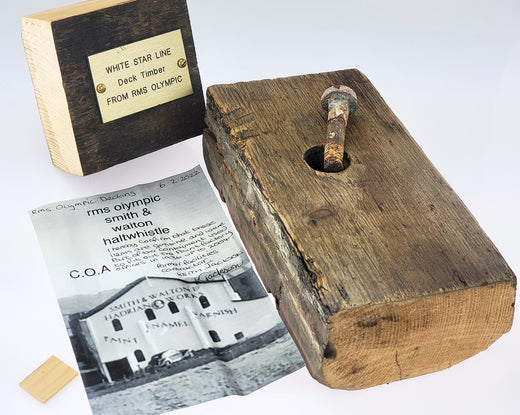This Limited Edition Fine Art Print includes a genuine relic from the RMS Olympic, one of the White Star Line's most celebrated ocean liners. Known as "Old Reliable," the Olympic was the sister ship to the famed RMS Titanic. During World War I, the Olympic earned its nickname through remarkable service, including an encounter on 12 May 1918 when she famously rammed and sank the German U-Boat U-103 while being pursued. This piece of history now accompanies the fine art print, allowing collectors to own a part of the vessel's storied legacy.
Details About the RELIC:
This relic is a genuine fragment from the deck of the RMS Olympic, the sister ship to the ill-fated Titanic, and represents a rare piece of maritime history. Built by Harland & Wolff in Belfast and launched in 1910, the Olympic was part of the White Star Line’s trio of iconic transatlantic liners. Known as the "Old Reliable," the Olympic had a storied career, including service as a troopship during World War I and later returning to transatlantic voyages. The ship continued to sail until her decommissioning and scrapping in 1935.
 Pieces from the deck of the Olympic used in the "Old Reliable" limited edition print
Pieces from the deck of the Olympic used in the "Old Reliable" limited edition print
During the scrapping process, much of the ship’s deck and interior fittings were repurposed. One of the most fascinating chapters in the Olympic's post-service life is the use of her decking as floorboards in the Haltwhistle Paint Factory, located in the UK. In 2004, Aces In Action acquired a series of deck fragments directly from K. Jackson, the former facilities contractor at the Smith & Walton Haltwhistle Paint Factory. These deck fragments, once walked upon by passengers of one of the most famous ocean liners in history, were carefully removed and preserved, offering collectors a unique connection to the Olympic's illustrious past.
 Piece from the deck of the Olympic used in the "Old Reliable" limited edition print
Piece from the deck of the Olympic used in the "Old Reliable" limited edition print
The Story Behind the Print:
On 12 May 1918, the RMS Olympic, known by her wartime designation as HMT Olympic and affectionately called “Old Reliable,” was repurposed from luxury liner to serve as a vital transatlantic troop transport during World War I. The largest ship pressed into wartime service at the time, she was freshly camouflaged and carried thousands of American troops across the Atlantic. This mission would mark one of the most dramatic moments in her career. Early that morning, as Olympic steamed through hostile waters, she was shadowed by the German U-boat U-103, which was preparing to launch a stern torpedo attack.
Spotting the danger, the crew of Olympic quickly manned her deck gun, striking the U-boat and rendering it immobile. Despite the initial success, Olympic's captain made the bold decision to continue the assault. Weighing 46,000 tons, Olympic charged at the helpless U-103 and, with her massive propellers cutting through the submarine’s hull, rammed the vessel. U-103 sank within minutes, making it the only warship to be sunk by a passenger merchant vessel during World War I.
This incredible act of naval warfare highlighted Olympic’s adaptability and solidified her status as "Old Reliable," a moniker earned not only for her wartime service but also for her resilience and reliability throughout her career. The sinking of U-103 remains a unique event in military history, a testament to the exceptional circumstances that led a luxury liner to become a symbol of Allied strength during the Great War.
Learn more about From Luxury Liner to Troop Ship—The Titanic Sister’s Unsung Valor from the Olympic’s War Service? Click Here
To purchase or see similar items, visit here.
Commissioned by Museums, Treasured by Collectors





Share:
Goodbye 2021 - Hello 2022
Red Trout, Blue Trout, Green Trout, Brook Trout...